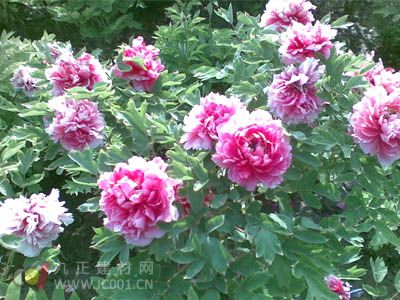Peony Introduction
Alias: Baihuawang, Pride Huawang, Luhan, Muxi Medicine, Kao, Luoyang Wang, Fuguihua. Common varieties include: Embroidered Peach, Luhe Red, Yexinghua, Variable Leaf Wood, Xiaohuhong, Pingdinghong, Yingjinhong, Zhuangyuanhong, Jinqihong, Yingcuihong, Chaoyanghong, Jinhongsatin, Caozhouhong, Zihonglou, Silver Beads, Large Petals Red, Jade Face Peach Blossoms, White Flowers Fight Spring, Baiyuan Hongxia, Lotus Peony, and Full House Hibiscus. Morphological characteristics: The plant typically grows to about 2 cm in height, with erect branches clustered at the rhizome. The branches are smooth and yellow-brown. Leaves are alternate, pinnately compound, with lanceolate or egg-shaped leaflets. The upper surface of the leaves is dark green or yellow-green, while the underside is gray-green, smooth, and some varieties may have fine hairs. Flowers bloom at the top of the branches, large and colorful, available in white, yellow, pink, red, purple, and green hues. Peony propagation methods include: 1. Division method: Typically done in autumn. Select a healthy mother plant aged 4 to 5 years. Carefully remove the soil from the roots, separate the rhizome into sections with buds and roots, and treat the cut surfaces with carbendazim solution before planting in well-draining soil. 2. Grafting method: This includes root grafting and branch grafting. The best time for grafting is around September. Strong, disease-free peony roots or rootstocks about 25 cm long are used. After drying for 2–3 days, they are grafted. Branch grafting can be done using either soil connection or abdominal grafting techniques. Soil connection is usually performed before and after the autumn equinox, while abdominal grafting is done between mid-July and mid-August. 3. Seed propagation: Harvested fruits should be dried in a cool, ventilated area. When the seed coat turns black and the fruit opens naturally, the seeds are sown after 2–3 days of drying. 4. Bud grafting: Done at the end of May or early June. Choose strong 2–3-year-old branches, make a small injury on the current year’s shoots, press them down, cover with soil, and place stones or weights on top. Keep the soil moist. Once the new roots develop sufficiently, the plants can be transplanted the following year. Light and temperature: Peonies prefer cooler climates and do not tolerate extreme cold well. The ideal growing temperature ranges between 16°C and 20°C. Soil: They thrive in loose, fertile, well-drained loam soil. Watering: Peonies have deep fleshy roots and are sensitive to waterlogging. Watering should be moderate, allowing the soil to dry slightly between waterings. Fertilization: Use rich base fertilizer when transplanting. Apply three rounds of fertilizer annually—apply a diluted phosphate fertilizer half a month before flowering, a compound fertilizer half a month after flowering, and compost at the end of autumn. Buying tips: Look for plants with straight trunks and thick branches. It's best to choose varieties that are resistant to pests and diseases for better growth and longevity.
Zhejiang Sealand Technology Co., Ltd.is a trustworthy supplier of Oil Mass Flow Meter, Oil Mass Flowmeter, Oil Coriolis Flow Meter, Oil Coriolis Flowmeter, Oil Coriolis Flow Meter, ATEX, IECEx & CE approved.
Operating Environment
Atmospheric pressure: 85kPa~106kPa
Ambient temp.: Refer to Chapter 1.6
Relative humidity: 5%~95%, non condensing
Operating conditions
Fluid: Liquid/Gas
Nominal pressure: 4MPa or 25MPa (Customizable)
Supply voltage: AC 85~265VAC, 50/60Hz or DC 12~24VDC(±5%), 5W
Outputs: Pulse 0~10KHz, RS-485, 4-20mA & HART (optional)
The meter consists of mass flow sensor and transmitter. Mass flow sensor is a phase-sensitive resonant sensor based on Coriolis effect, composed
of vibration tube, signal detector, concussion driver, structural support, shell, etc.
Mass flow transmitter is a micro-programming-centered electronic system, which supplies
thrust to sensor, transforms sensor signal into mass flow signal & others, and improves
accuracy in accordance with temperature parameter.
Oil Mass Flow Meter, Oil Mass Flowmeter, Oil Coriolis Flow Meter, Oil Coriolis Flowmeter, Oil Coriolis Flow Meter Zhejiang Sealand Technology Co., Ltd. , https://www.sealandflowmeter.com
Fluid temperature: -200°C~+200°C (higher temp. model is customizable)
It`s composed of switching power supplier, guard grating, core processor board, display
module, etc., installed in a ex-proof junction box. Switching power supply offers power for
transmitter; safe grating isolates sensor and transmitter intrinsically; core processor detects
& processes sensor phase signal, sends mass flow signal and process communication.